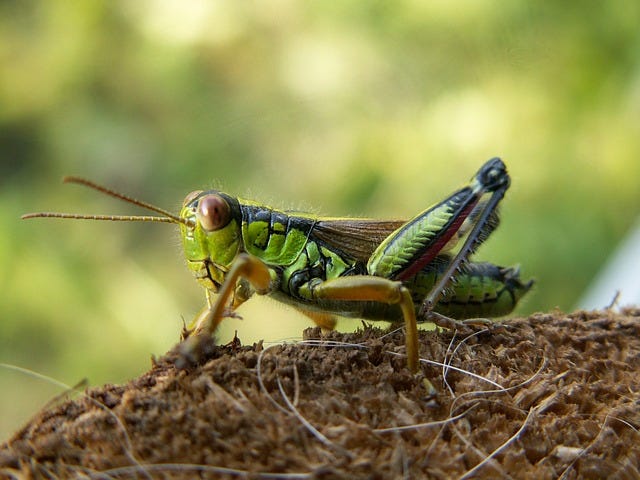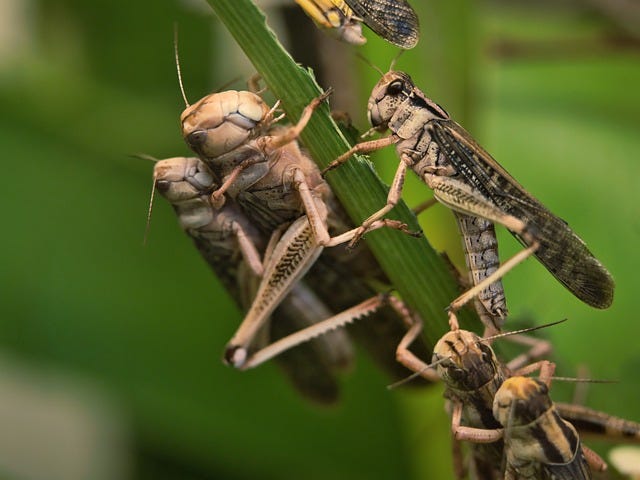Greetings!
I suppose it is rather mundane to discuss the weather but honestly, it’s what’s on my mind. As I write this, a pleasing ray of sun, coming through the window at a perfect angle so as not to blind me or impair my view of my monitor, is bathing me in its warmth. It’s only felt like spring here for a couple of weeks with sunny weather and temps in the 50s - 60s, so this is still a novelty. However, starting this weekend, it’s supposed to get up into the 90s for about 4 days. We generally don’t get too many 90+ degree days in the summer, so to hit in May is quite a surprise.
This Week
My daughter and I went to her college’s native plant sale last week and ended up with 17 plants, mostly shrubs, so we can get a start on blocking out our inconsiderate neighbor. As some of you may recall, he’s the one who devastated a good portion of what was once a gorgeous 10-acre forest. Anyway, we have a lot of planting to do! I suspect much of it will happen this weekend.
Oh! My son is such a sweet guy! Last week, he and his girlfriend went to see the touring Broadway musical, “Come From Away,” which they loved. He called me Friday morning to let me know there were some bargain tickets available, in the teens, for this last weekend. This is an amazing deal - especially since there were many tickets still for sale in the $100-200+ range.
Sadly, I couldn’t find anyone to go with me, so figured I was going to miss out. Friday night he called me from work to see if I want to go to the show. He managed to swap shifts so we could go see it together. It meant he was going to have to work a 6:00 am shift, which he never does, so it was a bit of a sacrifice. Granted, he really wanted to see it again. We went and had a great time - and saw a fantastic show from really good seats!
There is a filmed version of the stage production on Apple TV+ now. I haven’t seen it, yet, but it looks just like the one we saw, possibly with some of the same actors. I am saving it to watch as a special treat.
“Come From Away” is the true story of a small community in Newfoundland that was forced to play host to 7000 passengers from 38 planes that were grounded there on 9/11. The show is intense, funny, and most of all, uplifting. It’s hard to imagine that a show about 9/11 could make you feel better about humanity, but this truly does. Also - the music is wonderful. I highly recommend it!
Full Speed Ahead
What About…?
Grasshoppers

Last week we discussed fireflies, an insect with pretty much a 100% popularity rating. This week, the topic is grasshoppers, which are arguably less popular. My friends and I used to have fun trying to catch them when I was a kid. On the occasions we were successful, watching and feeling them leap from our hands was quite a thrill. Their legs actually work like tiny catapults launching them far into the air where, if they wish, their wings take over for an efficient escape. Kids tend to love grasshoppers, but farmers and gardeners generally do not. They can be extreme pests to plants and veggies with some species known to wipe out entire crops.
There are over 11,000 species of grasshoppers.
Grasshoppers range from less than 1/2” to about 4” (1 1/4 cm to 10 cm).
Grasshoppers have simple “ears” on their abdomen. They are called tympanal organs.
The well-known chirping sound of grasshoppers is created when the male rubs the ridged part of one of his hind legs against the firm edge of one of the front wings. This is called “stridulation” and is similar in concept to how humans can make a sound by rubbing a fingernail against the teeth of a comb.
According to the Scientific American journal, grasshoppers can leap about 10x their body length when jumping vertically and 20x their body length when jumping horizontally. To put that into perspective, that is like a human jumping up a 5-story building or crossing a football field in 3 leaps.
Grasshoppers are not just champion jumpers. They have two sets of wings; a front pair that is thick and leathery and protects a back pair that is light and delicate. Most grasshoppers are skilled flyers.
Grasshoppers are said to spit “tobacco juice”. This isn’t entirely accurate but is sometimes true. When threatened, grasshoppers spit or regurgitate brown liquid that is partially digested plant parts and digestive enzymes. If the grasshopper has eaten tobacco leaves, then it is spitting tobacco juice, at least, in part. Basically, it sounds to me like they get scared and throw up. Scientists believe this is a defensive act to show predators that they taste and smell bad.
Exploring More
Grasshoppers - The Dr. Jekyll and Mr. Hyde of Insects
While researching the historical and cultural significance of grasshoppers, I discovered a fascinating paradox. Grasshoppers are often associated with carefree times and good luck but are also culturally tied in with laziness, devastation, and bad luck. How and why does such a contradiction exist?
The Positives
Kids worldwide enjoy playing with grasshoppers. For many, the chirping of grasshoppers is a pleasant sound of summer. From Mexico to Africa and places in between, grasshoppers are seen as a food source, as well as having medicinal purposes.
Eastern cultures tend to see grasshoppers as good omens. In China, grasshoppers are associated with good luck, health, happiness, and fertility. In Japan, they are seen as signs of good luck, wealth, success, and abundance.
Ancient Greeks saw grasshoppers as symbols of dignity and prosperity. They were associated with the city and people of Athens, and jewelry depicting grasshoppers was worn as a sign of civic pride.
Native Americans who were hunter-gatherers saw grasshoppers as powerful beings who could predict or even control the weather and who provided the first tobacco.
In England, the grasshopper plays a prominent role at the Royal Exchange, a commerce building founded in the 16th century by Sir Thomas. It is said a grasshopper’s song helped a woman find Thomas, abandoned in a field as a baby, and that due to its heroic role in the rescue, grasshoppers are now associated with the Royal Exchange.
As for where grasshoppers land in the whole circle of life, they are an important part of the diet of many birds, small mammals, reptiles, amphibians, and more.
The Negatives
When many of us think about grasshoppers, we don’t imagine anything particularly threatening, however, when we call them locusts, a pall of doom creeps in and a sense of foreboding takes over. In a surprising stunt that only nature can pull off, some species of grasshoppers have the ability to shift from happy solitary creatures into gregarious swarms of locusts with voracious appetites. They physically become larger, darker, and move more, so it’s a remarkable transformation. Though we still have a lot to learn about how and why this happens, scientists have linked the change to an increase in serotonin levels.
Swarms of locusts are huge and devastating, destroying almost all crops they land on. Humans have been dealing with plagues of locusts for thousands of years. Stone tablets from around 3200 BC depict them, and there is documentation of locust management as it relates to agriculture going back thousands of years in Chinese, Egyptian, Hebrew, Greek, and Roman cultures.
The types of devastation left in the wake of locust swarms impact communities on local and national levels for years. They leave problems of food scarcity, economic devastation, mass migration of humans, and long-term educational impacts.
The largest locust swarm ever recorded took place in 1875 in the Midwest area of the United States. It covered 198,000 square miles - making it bigger than the entire state of California. The swarm was estimated to consist of several trillion locusts. (If this is creeping you out, you are not alone! Me, too, for sure!) For literary enthusiasts, Laura Ingalls Wilder wrote a very accurate description of the locust invasion in On the Banks of Plum Creek.
“The Cloud was hailing grasshoppers. The cloud was grasshoppers. Their bodies hid the sun and made darkness. Their thin, large wings gleamed and glittered. The rasping whirring of their wings filled the whole air and they hit the ground and the house with the noise of a hailstorm.”
Locust swarms are still a problem today, with some of the worst swarms impacting East Africa, the Arabian Peninsula, and the Indian subcontinent.
Given that locusts are so devastating, it’s not surprising that some cultures consider grasshoppers bad luck or associate them with undesirable characteristics. This is especially true in many African cultures, as well as Native American ones that relied on agriculture.
On a positive note, new technology including satellites, GPS services, and smartphones are being utilized to track and combat locust swarms, using pesticides to kill them before they can produce eggs. Scientists are also working on solutions that will not be as harmful to the environment as pesticides, such as a targeted fungus, or a chemical that would block serotonin so the transformation from grasshopper to locust could not occur.
Love them, or hate them, grasshoppers, and their hopped-up “party-like-a-rockstar” alter egos, locusts, have thrived for thousands of years and seem likely to continue doing so.
Main Resources:
Journal of Ethnobiology and Ethnomedicine
If you liked this issue, please click on the heart at the bottom or top of this message. I love knowing there are readers out there enjoying my work. ❤️
Have a lovely weekend. If you get the chance, watch a grasshopper, or perhaps a bee, or a worm. It’s an effective way to slow down and bring a new perspective into your awareness.
Peace,
Dakota Duncan
Not yet a subscriber?
Have a friend who enjoys wildlife? Please feel free to share.
Did you know I wrote a graphic novel? Check it out on my website: dakotaduncan.com








Thanks again for an entertaining and informative article. I, too, have seen Come From Away and loved it! As you said, it restores your faith in humanity. At least for a few minutes.